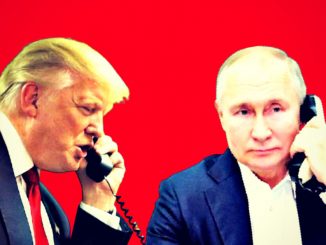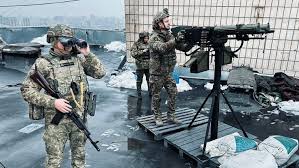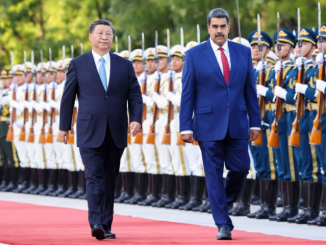
| Published June 30, 2025
Maxar Technologies imagery shows excavators and personnel attempting repairs at damaged Fordow enrichment facility
Satellite imagery captured on June 29 by Maxar Technologies reveals a striking scene at Iran’s heavily fortified Fordow Uranium Enrichment Plant—the aftermath of U.S. bunker-buster airstrikes under Operation Midnight Hammer is now marked by roaring machinery and flurries of activity.
🧱 What the Satellite Photos Show
-
Heavy equipment—excavators, cranes, bulldozers—has been deployed at tunnel entrances and ventilation shafts to clear rubble and assess structural damage
-
Visible craters pockmark access roads; protective berms and new earthworks hint at repair efforts .
Timeline of Attacks
-
June 13–14: Initial airstrikes by Israel targeted surface areas of Fordow, Natanz, and Isfahan. Satellite data even before the U.S. strikes indicated Iran may have relocated enriched uranium
-
June 22: The U.S. struck Fordow with 12–14 GBU‑57 bunker-buster bombs delivered by B‑2 stealth bombers, leaving behind deep craters and ash blanketing the site
-
June 25–26: The IAEA confirmed “enormous damage” but has not verified the demolition of subterranean facilities
Diverging Assessments
-
U.S. and Israeli officials: Assert the strikes inflicted “severe” or even “obliterating” damage, potentially setting Iran’s nuclear program back by years
-
U.S. DIA leak & independent analysts: Believe the effect is more short-term—delaying, not eliminating, Iran’s capabilities. Preliminary assessments indicate that enriched uranium and centrifuge components may have been relocated before the strike
-
IAEA observations: Confirm serious infrastructural damage but have not ruled out continued or concealed nuclear activity .
Iran’s Repair Effort
Recent imagery shows earnest cleanup operations underway:
-
Active personnel and machinery clearing debris.
-
Potential repair of damaged tunnel access.
-
No signs of reactivation of centrifuges, but visible construction implies containment and access restoration efforts
What’s Next—and What’s at Stake
-
IAEA inspectors are almost certainly blocked from the site. Tracking potential relocation of uranium or centrifuges is becoming difficult
-
Strategic ambiguity may benefit both Iran (who could regroup clandestinely) and the U.S./Israel (who gain time while diplomatic pressure mounts).
-
The long-term outcome hinges on whether inspections resume, Iran shares data on relocated material, or further military action is launched .
 Implications
Implications
The satellite imagery of Iran’s rapid cleanup efforts at the Fordow nuclear site has profound implications, both regionally and globally. Here’s what’s at stake:
⚠️ 1. Nuclear Program Not Neutralized
While Fordow sustained visible damage, the intense cleanup indicates Iran’s intent to restore or preserve capabilities. If key centrifuges or uranium stockpiles were relocated prior to the strikes—as many intelligence sources suspect—the nuclear program may only be delayed, not dismantled.
Implication: A “temporary setback” could embolden Iran to accelerate development at secret or alternate sites, raising the stakes for future detection and diplomacy.
🕵️♂️ 2. IAEA Access Undermined
Post-strike, Iran has blocked international inspectors from Fordow. This lack of transparency disrupts global monitoring efforts and violates non-proliferation norms under the Nuclear Non-Proliferation Treaty (NPT).
Implication: Without verified inspections, Iran can plausibly deny weaponization while continuing covert activities, eroding trust in global arms-control frameworks.
🛰️ 3. Aerial Surveillance Now a Key Player
With physical inspections stalled, Western powers increasingly depend on satellite intelligence to monitor Iran’s activities. The recent Maxar images demonstrate how open-source surveillance is becoming a core tool for verification and narrative control.
Implication: High-res satellite imagery now plays a central role in global accountability—both for intelligence agencies and public diplomacy.
💣 4. Escalation Risk Still High
The U.S. and Israeli strikes have triggered military tension across the region. Iran’s cleanup may be read as defiance or preparation for retaliation—militarily or via proxy groups like Hezbollah.
Implication: Further escalation could drag the Middle East into broader conflict, especially if Iran resumes enrichment at pre-strike levels or retaliates indirectly.
🧭 5. Diplomacy’s Path Has Narrowed
International hopes for nuclear diplomacy are dimmer than ever. The strikes, while tactically effective, may have hardened Tehran’s stance and given hardliners leverage against negotiation or compromise.
Implication: Future talks—if they resume—will likely come from a place of distrust and strategic misdirection, complicating any return to a deal like the JCPOA.
 Overall Takeaway: A Pivotal Moment in the Nuclear Standoff
Overall Takeaway: A Pivotal Moment in the Nuclear Standoff
The latest satellite imagery of Iran’s frantic cleanup at the Fordow nuclear site underscores a critical turning point—not just in the U.S.-Iran conflict, but in the global non-proliferation regime. While the physical scars of the June airstrikes are evident, the strategic consequences remain clouded by secrecy, denial, and geopolitical posturing.
Despite the strikes’ tactical success, the swift Iranian response suggests resilience and a possible shift to more concealed or dispersed nuclear operations. With inspectors locked out, tensions rising, and trust eroding, the world faces a narrowing window to de-escalate the crisis diplomatically. What happens at Fordow may no longer stay underground—its reverberations are already shaking the foundations of global nuclear oversight.
SOURCES: FOX NEWS – New satellite imagery shows ongoing activity at Iran’s Fordow nuclear complex after US airstrikes
REDSTATE – New Satellite Images Show Iranians Feverishly Trying to Clean Up the Mess at Fordow Nuclear Site





Be the first to comment